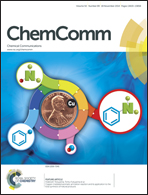Fragmentation of the quinoxaline N-oxide bond to the ˙OH radical upon one-electron bioreduction†
Abstract
The ˙OH radical is released from 3-trifluoromethyl-quinoxaline 1,4-dioxides upon one-electron reduction by cytochrome P450 oxidoreductase. This process effectively competes with back oxidation of the intermediate radical anion by oxygen and underlies the increased aerobic cytotoxicity of such compounds compared to that seen for the related clinical bioreductive benzotriazine drug, tirapazamine.


 Please wait while we load your content...
Please wait while we load your content...